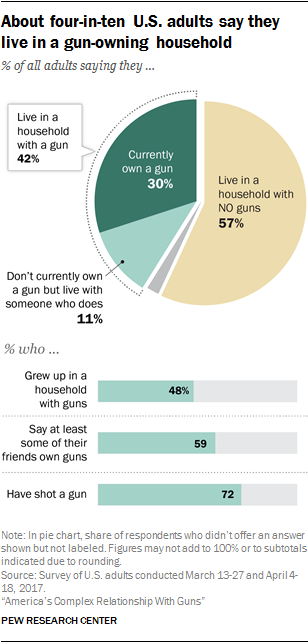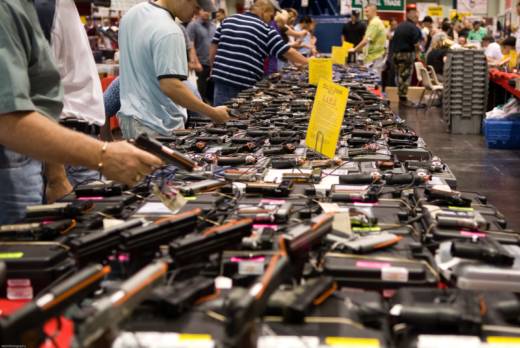Washington Post video
In recent years, the latter faction has been undeniably victorious.
Passing new national gun control measures has proven all but impossible in a country where the right to bear arms is enshrined in the Constitution's Second Amendment, and where the gun rights lobby wields enormous political influence. Led by the efforts of the powerful National Rifle Association, firearms advocates stand firmly against almost any new restrictions, and through effective political organizing and generous campaign contributions, have successfully thwarted all recent efforts to enact tougher regulations.
[RELATED: TIMELINE OF U.S. GUN CONTROL EFFORTS]
It's not so much that Americans are more violent than people in other countries, we're just way more lethal.
Many gun rights proponents consider ownership a U.S. birthright, a protection as essential as freedom of speech. Even though the number of U.S. households with guns has actually fallen in recent decades, the rate of firearms per capita here is still by far the highest in the world: nearly three of every 10 adults owns a firearm, according to a recent Pew Research survey. Today, there are an estimated 350 million civilian-owned firearms in the U.S. That's more guns than people.

Although mass shootings receive the most attention, they actually make up only a tiny percentage of America's hefty gun carnage. The U.S. has far higher rates of gun violence than any other developed nation. In 2015 alone, more than 36,000 people were killed by firearms, just shy of the total number killed in auto accidents, according to the Centers for Disease Control and Prevention.
The map below is based on data from the Centers for Disease Control and Prevention's analysis of 2016 death certificates. It factors in all reported gun-related deaths, including homicides, accidents and suicides (the latter of which make up about two-thirds of gun deaths nationwide). There were more than 38,000 reported gun deaths in 2016, according to CDC data, a rate of about 12 per 100,000 people. It marks the second straight year that gun deaths have risen. There were about 4,000 more gun deaths in 2016 than the previous year.
Gun ownership rates are derived from the results of a 2013 survey published in the health journal Injury Prevention. 4,000 adults (18 years and up ) were surveyed from 50 states. One-third of all respondents reported owning a gun (of any type), ranging from 5.2 percent in Delaware to 61.7 percent in Alaska.
2016 gun control rankings are from the Law Center to Prevent Gun Violence, a group that advocates for stronger gun control laws and assigns grades to each state based on the strength of policies like background checks, concealed carry permits, bulk firearms purchasing and gun carry restrictions in schools and other public spaces. The National Rifle Association has its own rundown and interpretation of state laws here.
But while popular support for stricter gun laws does typically increase in the wake of major mass shootings, the sentiment doesn't usually last long, as Congress neglects to act and eventually moves on to a different issue.
There's little disagreement among Americans that gun violence is a problem: more than 80 percent consider it a major issue, including 50 percent who call it "a very big problem," according to the Pew poll.
A sharp divide emerges however, often along partisan lines, in how to address the problem. While almost half of respondents in the same poll said there would be fewer mass shootings in the U.S. if it were harder for people to legally obtain guns, nearly 40 percent said more restrictions on ownership wouldn't make any difference. And a full 13 percent said that doing so would lead to more mass shootings, a belief espoused by NRA Executive Vice President Wayne LaPierre, who famously said: "The only thing that stops a bad guy with a gun is a good guy with a gun."
In fact, U.S. gun sales typically spike after mass shootings, a consequence of more people feeling unsafe and wanting to protect themselves, as well as an increased concern that such incidents will prompt stricter regulations and make it harder to buy guns.
Proponents of stricter regulations are quick to note the correlation between America's high rates of gun ownership and gun violence. But gun rights advocates often argue that there are other factors at play, and these statistics don't indicate a cause-and-effect relationship. They note for instance that gun homicide and other gun crimes in the U.S. have fallen sharply since peaking in the early 1990s, even as gun ownership remains high.
Explore the interactive graphic below, produced by FiveThirtyEight, based on 2014 CDC data, to learn more about the victims and perpetrators of America's ongoing gun violence epidemic.
The Law Center to Prevent Gun Violence points to a 2010 statistic showing that seven out of 10 states with the strictest regulations also have the lowest gun homicide rates.
But gun rights advocates opposed to tighter regulations argue that this a misleading comparison. One common rebuttal is that stricter regulations do little to prevent criminals from getting hold of guns; they simply prevent law-abiding citizens from being able to protect themselves. Gun rights advocates also often point to states like Maine, which has some of the loosest regulations in the country (it received an F grade by gun control groups) but also has a relatively low gun death rate. They also argue that strict gun laws in cities like Chicago and Washington, D.C., have failed to prevent high gun homicide rates.

